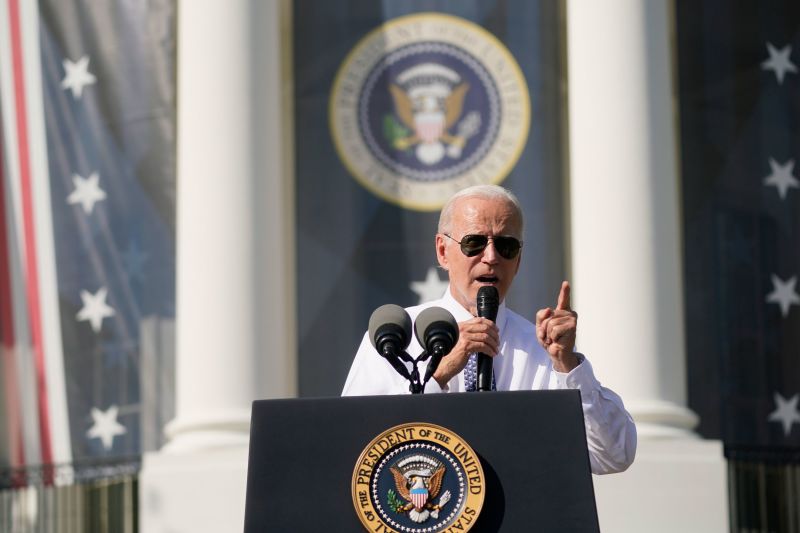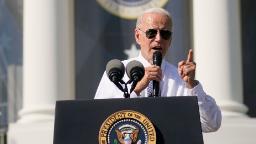CNN
—
It was an unfortunate moment for Joe Biden to be celebrating.
The President staged his latest victory lap on Tuesday for the health care and climate law that Democrats hope will boost enthusiasm ahead of the midterm elections in November that could make him a domestic lame duck.
But the crowd on the sun-baked South Lawn of the White House cheered the controversially named Inflation Reduction Act only hours after punishing new government data showing food prices soaring. Stocks were meanwhile plummeting in the Dow Jones Industrial Average’s largest one-day reverse since June 2020 in the darkest days of the pandemic.
The slump came on the back of new figures that showed inflation still a corrosive force in August, despite big falls in gasoline prices. All this probably means more aggressive action from the Federal Reserve next week to curb inflation amid fears the central bank’s harsh medicine could throw the economy into recession and cool a strong job market.
Behind the scenes, as Biden marked what once seemed an unlikely legislative victory, his team was working frantically to avert a freight rail strike that could break out on Friday. A stoppage would be a disaster since it could cost several billions of dollars a day and further clog supply chains that already contributed to the rising inflation that have hurt so many Americans this year. Food shortages could occur, sending prices of staple goods soaring once again.
Presidents often cannot control the economy’s trajectory, but it was an inopportune matter of scheduling that Biden was on Tuesday thumping Democratic chests on a bill that pours hundreds of billions more dollars into an already overheating economy.
Past the poor optics, the new storm clouds underscored the tenuous nature of signs of slowed inflation that have contributed to a late summer spurt of political momentum for Democrats ahead of elections in which they’re trying to hold into their narrow House and Senate majorities.
And yet, on a day when disappointing economic data would seem to provide Republicans an opportunity to hammer home their attacks on Democrats over inflation, they were distracted by their own abortion politics after South Carolina Sen. Lindsey Graham unveiled a bill to ban the procedure after 15 weeks. Abortion has put Republicans on the defensive in the wake of the publicly unpopular Supreme Court decision overturning Roe v. Wade, and the lukewarm reception Graham’s proposal received from Minority Leader Mitch McConnell spoke to how electorally toxic it might be.
Tuesday’s data highlights the fragile foundation of an economic recovery from a once-in-a-century pandemic that does have undeniable strong points for Biden to highlight, but that also leaves far too many Americans facing real pain.
The President on Tuesday conjured a political message suggesting a national and a personal political resurgence after a dark time, mirroring the sentiments sung by his warm-up act James Taylor: “I’ve seen fire and I’ve seen rain.” Despite the upbeat mood, however, the country seems far from the “sunny days that I thought would never end,” also evoked in Taylor’s hit.
Still, Biden hailed this summer’s Inflation Reduction Act and the infrastructure deal he signed last year as huge wins for serious legislators over special interests and an example of how competent government could work for every US citizen.
“Today offers proof that the soul of America is vibrant, the future of America is bright, and the promise of America is real,” he said.
Senate Majority Leader Chuck Schumer, a New York Democrat, drove home the political point, declaring, “Not a single Republican joined us to make these new investments in new jobs possible, not one.”
The mood of optimism in the White House was born out of what looked for months like a failed Biden agenda. The President’s roster of achievements on Capitol Hill now stands in favorable comparison with most recent administrations as midterm elections, which are traditionally troublesome for first-term commanders in chief, approach.
Some polls are showing Democrats ticking up in the generic congressional ballot ahead of November, and expectations for an overwhelming red wave have been tempered amid a shifting political landscape following the Supreme Court’s abortion decision. And yet the unpredictable nature of the economy, which is pumping out jobs but remains deeply challenging for many Americans, means it may still be hard for Democrats to beat the historical odds of the party in power losing seats during a first-term president’s midterms.
When the Inflation Reduction Act passed last month, after months of wrangling between progressives and moderate Democratic Sen. Joe Manchin of West Virginia, there was a fierce debate over whether it would live up to its name.
The White House insists it will do exactly what it says it will because it will, for example, lead to lower prescription drug costs for seniors. But most analysts argue that any such deflationary effects will unfold in the long term. Certainly most Americans will not see much impact before they cast their votes in November, or before as early voting begins in many states in the coming weeks.
The White House pointed to progress in Tuesday’s inflation report. It’s true that while prices were up 8.3% year on year, they dipped down from an 8.5% hike in July and a 9.1% spike in June.
“Overall, prices have been essentially flat in our country these last two months: that is welcome news for American families, with more work still to do,” Biden said in a statement. But that was a rather selective reading of a report that showed just how high the burden is of near 40-year highs in the cost of living. In fact, food prices spiked 11.4% over the past year, the largest annual increase since May 1979, according to the Bureau of Labor Statistics data. Egg prices soared 39.8% from a year ago, flour is 23.3% more expensive. Milk is up 17% and bread jumped 16.2%. Rents, medical care and new cars are all more pricey than they were a year ago.
Such figures explain why inflation is such a pernicious force – everyone feels it, and it hammers the poorest Americans disproportionately. No amount of statements that things are getting better from Biden will alleviate disillusionment that voters will feel in the aisles of their grocery stores, even if gas prices have been falling almost every day for weeks.
The disappointing inflation report helps explain why stocks tanked on Tuesday amid rising investor concern that the Fed could overcook its response – with another 75-basis-point hike in interest rates expected next week – and tip the economy into a contraction. The Dow dropped 3.9%, the S&P 500 was off 4.3% and the Nasdaq fell 5.2%. Stock prices often rebound quickly, but such huge one-day slumps are unsettling for Americans with their pensions invested in the market. And they further chip away at confidence in the economy that can be reflected in voting patterns come Election Day.
Renewed concern over inflation also comes as anxiety mounts over another possibly politically significant shock to consumers. CNN reported this week that some White House officials worry about a consequential rise in energy prices for Americans this winter, as Russian President Vladimir Putin crimps the supply of natural gas to Europe as part of the new Cold War-style showdown caused by the West’s opposition to his invasion of Ukraine.
As if the current economic conditions weren’t challenging enough, the administration is battling to stave off a new threat – a strike on the nation’s freight rail network that could occur as soon as Friday if no agreement is reached.
Biden and White House officials have been burning up phone lines to union leaders and industry chiefs to stave off the industrial action that the Association of American Railroads predicts could cost more than $2 billion per day and lead to food and agricultural shortages, manufacturing shutdowns and job losses. A strike would be another blow to supply chains that ground to a halt in the pandemic and contributed to the rise in inflation. The freight rail network plays a critical yet often unnoticed role in American life. In a letter to members of Congress this week, the American Trucking Associations warned that a freight shutdown would require an extra 460,000 trucks – an impossible goal – to move goods by road, especially given the current shortage of 80,000 drivers.
The dispute puts Biden in a tough position, creating a conflict between his longstanding support for unionized labor and his immediate political imperative to avoid any other disastrous hits to the economy with elections in less than two months. The White House confirmed on Tuesday that the President spoke to both rail unions and freight companies the day before while visiting Boston. Union officials and representatives of the railroads are headed to Washington, DC, on Wednesday to meet with Labor Secretary Marty Walsh, CNN reported Tuesday evening.
More than 60,000 rail freight workers could walk off the job on Friday if they cannot secure certain quality of life benefits and changes to a rostering system that requires engineers and conducts to be constantly on call to work.
Biden headed off a strike two months ago by imposing a 60-day cooling-off period during which a panel he appointed made recommendations for pay rises. But that period ends at 12:01 a.m. ET Friday, ending the President’s power to block strike action. Congress would be able to intervene but Democrats and Republicans would have to find rare agreement on what to do.
Politically, Biden can ill afford any more major economic disruption. And Americans more broadly have suffered so much already over the last few years.
But the freight dispute, and the one step-forward-two-steps-back nature of the economy after a tumultuous period, show that the organizing principle of Biden’s presidency – restoring the country to normal – remains a huge challenge. And they show just how quickly things could fall apart.








More News
Parts of Gaza in ‘Full-Blown Famine,’ U.N. Aid Official Says
Charges Against a Congressman Lay Bare Foreign Government Influence Attempts
Last of Escaped Zebras Captured With White Bread, Oats and ‘Positivity’